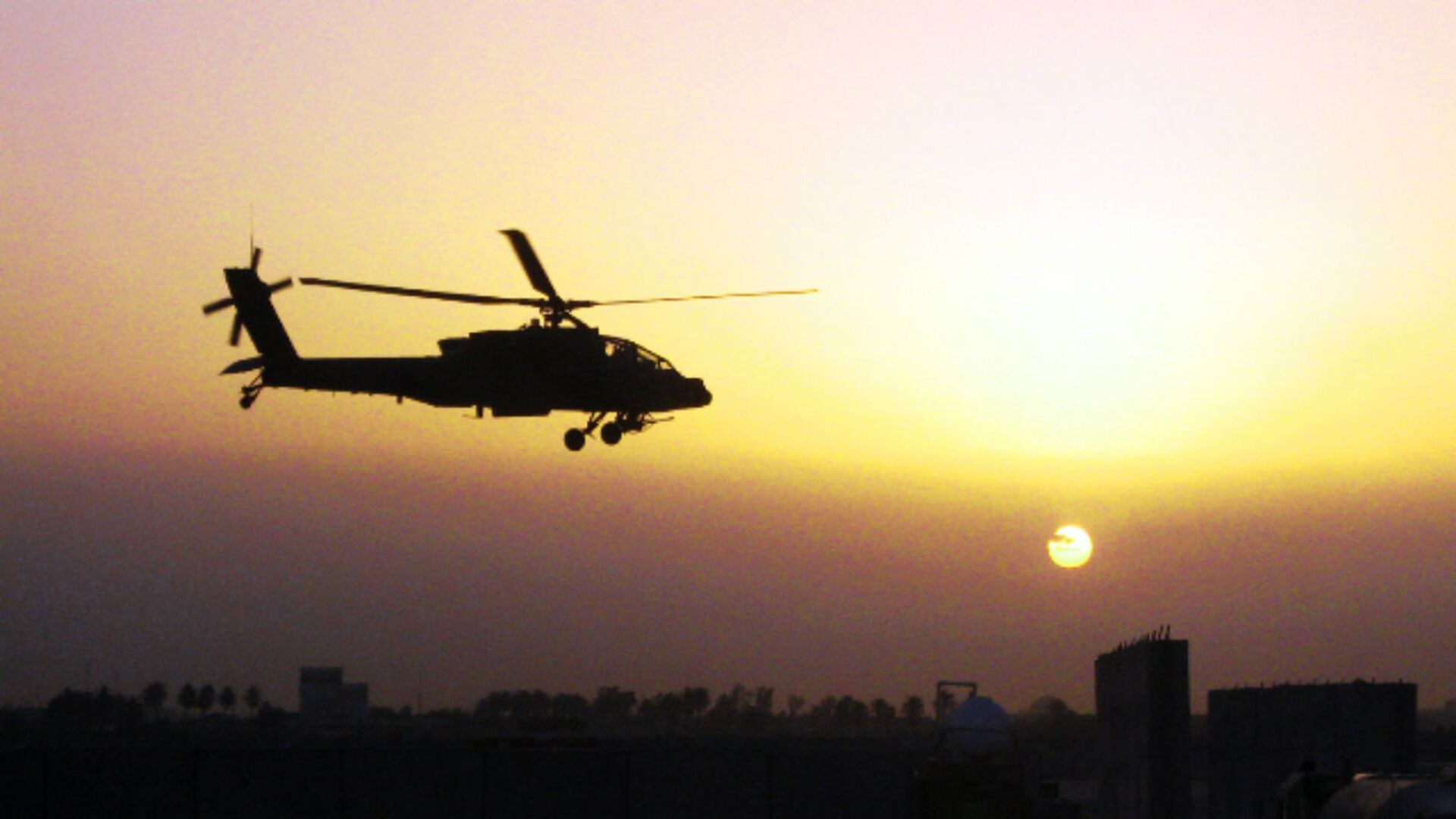https://sputnikglobe.com/20230428/us-army-chief-orders-aviation-stand-down-after-two-chopper-crashes-kill-12-soldiers-1109932498.html
US Army Chief Orders 'Aviation Stand Down' After Two Chopper Crashes Kill 12 Soldiers
US Army Chief Orders 'Aviation Stand Down' After Two Chopper Crashes Kill 12 Soldiers
Sputnik International
The US Army issued an across-the-board "aviation stand down" order on Friday after two recent helicopter crashes resulted in the deaths of 12 American service members.
2023-04-28T23:13+0000
2023-04-28T23:13+0000
2023-04-29T01:06+0000
military
us
us army
ah-64 apache
crash
apache helicopter
soldier
us troops
https://cdn1.img.sputnikglobe.com/img/103192/96/1031929692_0:0:1440:810_1920x0_80_0_0_51d8f8378113be7eff8169af3d5c3f5c.jpg
The US Army issued an across-the-board "aviation stand down" order on Friday after two recent helicopter crashes resulted in the deaths of 12 American service members.The most recent crash occurred Thursday when two AH-64 Apache helicopters collided in midair while returning from a training mission near Fort Wainwright, Alaska. That accident killed three servicemen and hospitalized another.The crash followed another training crash near Fort Campbell, Kentucky, where two HH-60 Blackhawk helicopters collided, killing nine servicemen. The statement released by the Army chief of staff said there was "no indication of any pattern between the two mishaps."The stand down order will ground all Army aviators who are not participating in critical missions and will remain in place until the pilots complete the required training.While it is not mentioned in the statement, there was another helicopter crash in Alaska in February in which an Apache chopper rolled after takeoff and injured two service personnel.An investigative team from Alabama is still making their way to the recent crash, according to US media. They are expected to reach the crash site by Saturday.The Army will review its risk management process, training, management, supervisory responsibility, flight-mission briefing process, crew selection, flight planning and other procedures during the stand down. The stand down will last from May 1 to May 5 for active-duty personnel. During that time they will be required to complete the stand down, which includes a briefing by senior officers on flight, maintenance and other safety issues. National Guard and Reserve units will have until May 31 to complete their safety training in order to accommodate the part-time soldiers in those units.According to a military media outlet, senior commanders "including generals" will be expected to participate in the briefings. Normal operations will resume after the stand down is completed and any safety issues are addressed.
Sputnik International
feedback@sputniknews.com
+74956456601
MIA „Rossiya Segodnya“
2023
News
en_EN
Sputnik International
feedback@sputniknews.com
+74956456601
MIA „Rossiya Segodnya“
Sputnik International
feedback@sputniknews.com
+74956456601
MIA „Rossiya Segodnya“
us army chief of staff, aviation standown, twin chopper crash, apache ah-64
us army chief of staff, aviation standown, twin chopper crash, apache ah-64
US Army Chief Orders 'Aviation Stand Down' After Two Chopper Crashes Kill 12 Soldiers
23:13 GMT 28.04.2023 (Updated: 01:06 GMT 29.04.2023) Three military helicopter crashes have occured during training exercises so far in 2023, two of which ended in fatalities.
The US Army issued an across-the-board "aviation stand down" order on Friday after two recent helicopter crashes resulted in the deaths of 12 American service members.
The most recent crash occurred Thursday when two AH-64 Apache helicopters collided in midair while returning from a training mission near Fort Wainwright, Alaska. That accident killed three servicemen and hospitalized another.
The crash followed another training crash near Fort Campbell, Kentucky, where two HH-60 Blackhawk helicopters collided, killing nine servicemen. The statement released by the Army chief of staff said there was "no indication of any pattern between the two mishaps."
The stand down order will ground all Army aviators who are not participating in critical missions and will remain in place until the pilots complete the required training.
"We are deeply saddened by those we have lost," Army Chief of Staff James McConville said in the statement. "It is their loss that makes it all the more important we review our safety procedures and training protocols, and ensure we are training and operating at the highest levels of safety and proficiency."
While it is not mentioned in the statement, there was another helicopter crash in Alaska in February in which an Apache chopper rolled after takeoff and injured two service personnel.
An investigative team from Alabama is still making their way to the recent crash, according to US media. They are expected to reach the crash site by Saturday.
The Army will review its risk management process, training, management, supervisory responsibility, flight-mission briefing process, crew selection, flight planning and other procedures during the stand down.
"The safety of our aviators is our top priority, and this stand down is an important step to make certain we are doing everything possible to prevent accidents and protect our personnel," McConville said. "During this stand down, we will focus on safety and training protocols to ensure our pilots and crews have the knowledge, training and awareness to safely complete their assigned mission."
The stand down will last from May 1 to May 5 for active-duty personnel. During that time they will be required to complete the stand down, which includes a briefing by senior officers on flight, maintenance and other safety issues. National Guard and Reserve units will have until May 31 to complete their safety training in order to accommodate the part-time soldiers in those units.
According to a
military media outlet, senior commanders "including generals" will be expected to participate in the briefings.
Normal operations will resume after the stand down is completed and any safety issues are addressed.


